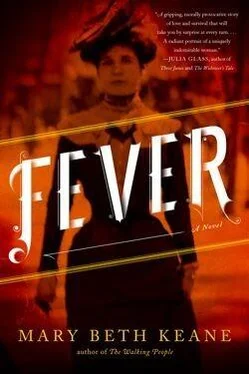“I can’t take it,” she used to say to Aunt Kate when she’d go home.
“You’ll take it,” Aunt Kate assured her. “You’ll take it like everyone else.”
• • •
She’d been repeating the words to herself since stepping onto the ferry: You are no longer a cook. You are a laundress. You signed the papers. Better to be a laundress in New York City than a cook trapped in a bungalow on an island of death.
The boardinghouse where she’d slept since Friday night served decent-enough food, to Mary’s surprise, but she didn’t like the company. Men slept on a different floor than the women, but they all took their meals together, and there was too much eyeing and gawking for Mary to be able to enjoy her plate. To the one wall-eyed man who kept breathing in her direction, and then whispered that he liked the look of her, she’d stated plainly that she’d make him sorry if he ever came near her. He’d laughed, the food he’d just eaten a pulp on his exposed tongue, but she’d stared at him without changing her expression. He snapped his mouth closed and turned back to his beef and barley.
When Mary walked into the laundry on that Monday morning in February 1910, she felt flat, tired, and hungry, as if all those years between hurrying after Paddy Brown in Castle Garden and that moment, pushing open the door to a Chinese laundry, were no more than a matter of weeks, and she was no older now than she’d been then. The laundry was on Washington Place and Greene Street, directly next to the taller Asch Building, and on Mary’s first day the entrance was blocked by a lake of icy slush so deep she had to hitch up her skirt to stride through it. It was a busy street, full of students from New York University and women working at the factories up and down the block.
The laundry was open to customers every day except for Sundays, and the washers, too, had the day off. But those who ironed and hung had to show up for at least four or five hours on Sundays in order to press and fold or hang what had been washed the day before. It was a small operation — a front room to welcome customers; a middle room where Chu, the owner, slept; and a back room where all the washing and pressing took place alongside a little kitchen and sitting area that they were allowed to use for thirty minutes out of every day. Chu did not speak to Mary, but directed all his instructions to another Chinese man named Li, and Li translated all Chu’s instructions for Mary. Here is where you stand, he told her. Here is how you wring. Here is how you shake out, how you hang, how you feel for dampness. In certain fabrics it was preferable to iron before completely dry; in others the garment must absolutely be bone-dry before touching with a hot iron or else the iron would stick, and the garment would burn, and Mary would be out of a day’s wages. The irons must be kept hot, but not so hot that they would scorch, and they must be kept clean. Mary would find, Li warned, that by the end of the day the irons would feel heavier, and Mary would be slower to move them, and so she should be on guard for this always. Everyone was to take turns up front if Chu was not available, or if he couldn’t make himself understood, or if the customer did not want to speak to a Chinese.
Li gave her the main instructions for handling the customers: No one, under any circumstances, could pick up laundry without a ticket unless Chu gave his explicit permission. Mary should not be surprised if people came in asking for clothes that had never existed, and then demanding compensation for those imaginary clothes. She must never concede. If she thought she was being swindled, she should stop and get help. Keep the cash drawer locked. And finally, because Mary spoke English, she’d be asked to serve as interpreter from time to time.
“But you speak English,” she said, interrupting him.
“You are white. They won’t try so many tricks with you. My father was born here, and me as well, but I still have a Chinese face.”
“But not as Chinese as Chu,” Mary said, before she’d stopped to think that maybe it wasn’t a good idea to have him know she’d been studying his unusual face.
Li regarded her with an expression she couldn’t read. “My mother was white. And my father’s mother. There are only two dozen Chinese women in all of New York City. Three dozen at the absolute most.” His face was very grave, and Mary knew that whether it was true or not, he believed it. Then when she thought about it, she realized she couldn’t remember ever seeing a Chinese woman. Not in the markets. Not on the streets. Not in the tenements. Nowhere.
“You are Irish, we know, and we hope that doesn’t cause trouble for us. The Irish cause trouble for the Chinese more than any other. You being here is a favor because Commissioner Lederle vouched for you.”
Mary didn’t know what to say to that, so she didn’t say anything.
“How do you know him, by the way? Did you work for his family?”
“No, I don’t know him,” Mary said quickly.
“Yes. Well,” Li said, and then told her to get to work. “He brings his shirts here from time to time.”
The work was as tedious as Mary remembered, with none of the magic that came with cooking. Where she needed only her knife and a pan of hot butter to turn a few ordinary, ugly spuds into something wonderful, the laundry offered no real transformations. The two Lithuanian women remained hunchbacked over their tubs of water all day long, their bodies angled to get strength in their arms where there wasn’t any left. They had red faces, and Mary supposed it was the physical effort of their work, and from keeping their noses so close to the hot water and its broth of chemicals made to strip the clothes of odor, of any evidence of the bodies that had worn them. After twenty minutes of instruction on the box, Mary was made the mangle woman. Li stood at the head of the contraption, a flat box about three feet long and ten inches high, and showed her how to wrap bed linens or tablecloths around the pins below, and then how to push the wheel on top to make the box roll over these large, flat items that didn’t need detailing or shape. Later, when she was done with the items that needed mangling, she could be boss of the irons, sanding and polishing the ones that had cooled. Amid all of this labor, this orchestra of pushing and pulling and wrestling with waterlogged fabrics, walked Chu, who gave Mary stern looks and clicked his tongue.
On Mary’s second day, she arrived at the laundry at the appointed time, but an hour into her work realized she’d been expecting something different that day, some slight deviation from the day before. By the third and fourth days she realized that there would never be any deviation. She arrived. Hung her coat. Pushed up her sleeves. Began to work. At precisely the noon hour she stopped to eat an apple and a wedge of cheese, while the Lithuanians sat across the table from her and made a picnic of black bread and dumplings stuffed with some kind of minced meat that Mary wanted to take apart with her fork and examine. They spoke in their own language and didn’t bother with Mary at all. At half noon she was back mangling, rolling the large, flat board over florals and plaids, linens and thin cottons. In the afternoons she marked time by the sudden surge of girls that spilled onto the sidewalk as the shift changed at the shirtwaist factory next door. The ones arriving called out greetings to one another as they hurried to the entrance. The ones leaving for the day stood in groups of three and four on the sidewalk outside the laundry and talked of their plans. Once in a while one of them would hold out her hand for the others to admire a new engagement ring. Listening to them, Mary felt apart from everything around her, as if someone had gotten hold of her and was warning her to stay quiet as she watched the hours and days of her life unfold, someone else playing the lead.
Читать дальше












